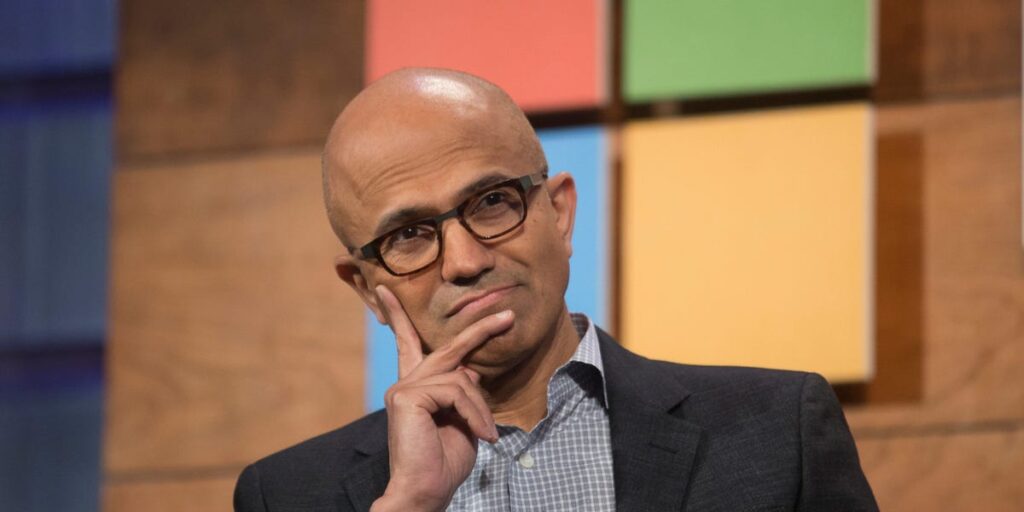- Microsoft has had three CEOs since its founding in 1975.
- Bill Gates, Steve Ballmer, and Satya Nadella have steered the company through its 50-year history.
- Read about the CEOs who oversaw Microsoft’s successes, failures, launches, acquisitions, and more.
Satya Nadella has been Microsoft’s CEO since February 4, 2014, and its executive chairman since June 2021. He is the company’s third CEO since its incorporation in 1975.
Let’s break down the company’s chief executives and their tenures:
Bill Gates (1975-2000)
The Microsoft Corporation was co-founded in 1975 by Bill Gates and Paul Allen, shortly after the pair dropped out of Harvard University. Gates said he dropped out of Harvard to found Microsoft because he feared missing out on being a pioneer of the personal computing revolution.
As the company’s first chief executive, Gates steered the company through its formative years and set forth Microsoft’s original mission of “a computer on every desk and in every home.” A pivotal moment came in 1980 when Microsoft secured a deal to supply the operating system for IBM’s first personal computer. To accomplish this, Microsoft purchased an existing operating system, modified it, and renamed it MS-DOS — short for Microsoft Disk Operating System — which became the foundation for the company’s early success.
In 1985, the company launched Windows 1.0, introducing the Graphical User Interface that made computing more accessible to the masses. Subsequent releases like Windows 3.0 in 1990 and the highly successful Windows 95 in 1995 built upon this innovation, with each release solidifying Microsoft’s operating system market dominance, which Microsoft enjoys to this day — in part due to the success of these earlier operating systems. Under Gates’ leadership, the company also developed the Microsoft Office suite, which became the industry standard for business productivity software.
The company’s rapid growth led to its Initial Public Offering (IPO) in 1986, making Gates a billionaire by the age of 31 and, at one point, the world’s richest man. Throughout the 1990s, Microsoft’s influence expanded globally, but it also faced significant legal challenges. In 1998, the US Department of Justice filed an antitrust lawsuit against Microsoft, accusing the corporate giant of monopolistic practices by bundling Internet Explorer with the Windows operating system. The prolonged legal battle brought scrutiny, but ultimately, the two parties reached a settlement in 2001 that imposed certain restrictions on Microsoft’s business practices.
Despite these challenges, Gates continued to drive innovation, investing heavily in research and development. Microsoft expanded into various areas, including enterprise software, internet services, and gaming, laying the groundwork for future ventures like the Xbox. Gates’ leadership emphasized not only technological advancement but also strategic business moves that kept Microsoft at the forefront of the industry.
After leading the company for its first 25 years, Gates resigned in 2000 to focus on his philanthropic efforts, founding the Bill and Melinda Gates Foundation that same year. His tenure left a significant mark on the industry, with Microsoft’s software becoming integral to personal and professional computing worldwide. Gates continued on as Microsoft’s chief software architect until 2006 and as company chairman until 2014, when Satya Nadella took over the role. Gates remained on the board as a technical advisor before stepping down entirely in 2020.
Steve Ballmer (2000-2014)
Steve Ballmer, who joined Microsoft in 1980 as the company’s first business manager, played a pivotal role in shaping its early business strategies. Ballmer succeeded Bill Gates as president and CEO of the company after the founder stepped down in 2000. Recognizing the need for agility in a rapidly evolving tech industry, he initiated extensive internal restructuring that favored speed and fewer bureaucratic hurdles.
With Ballmer at the helm, Microsoft faced significant successes, but also its fair share of challenges. In 2001, the company launched the Xbox, marking its entry into the gaming console market. The Xbox and its successors would come to rival and challenge the market dominance of the Sony PlayStation and Nintendo. The success seen by the Xbox and its successors helped cement Microsoft as a serious player in the entertainment sector.
Ballmer’s tenure also saw the release of Windows XP, an operating system so successful that it took until 2016 for another iteration of Windows to actually surpass Windows XP in terms of user base. The following year, it was still the third most popular operating system in the world, despite Windows XP’s retirement in April 2014.
However, not all initiatives fared so well. The release of Windows Vista in 2007 was met with widespread criticism due to performance issues and compatibility problems, tarnishing the reputation of Microsoft’s flagship operating system. Additionally, Microsoft’s efforts in the smartphone arena with Windows Mobile struggled to gain traction. Combined with the introduction of the Apple iPhone in 2007 and the rapid advancement of Google’s Android platform, this led to Microsoft ceding significant ground in the burgeoning mobile market that it never recovered. Microsoft tried again with the Windows Phone mobile operating system in October 2010 before throwing in the towel in 2017 and prioritizing iOS and Android development in 2018.
In an effort to bolster services, Microsoft acquired Skype, the video calling service, in 2011 for $8.5 billion. The Skype acquisition helped Microsoft gain valuable ground in both consumer and enterprise communication sectors that was not usurped until 2021 when Microsoft voluntarily replaced it in the business context with Microsoft Teams.
Despite the challenges that Microsoft confronted during Ballmer’s tenure as CEO, Microsoft experienced significant financial growth under his leadership. By the time Ballmer announced his retirement in 2013 and officially stepped down in February 2014, the company’s annual revenue had tripled. This growth reflected the company’s product portfolio expansion and its increased global market reach. Ballmer’s tenure was marked by his efforts to diversify Microsoft’s offerings and navigate the company through a transformative era in the technology industry, contending with fierce competition and headwinds while building on the company’s foundations.
Satya Nadella (2014-present)
Following Steve Ballmer’s resignation in February 2014, Satya Nadella took on the role of chief executive and chairman of the board.
Under Nadella’s leadership, the company has undergone a significant transformation from a traditional software provider to a leader in cloud computing and subscription services. Recognizing the shifting tech landscape, Nadella prioritized investment in cloud infrastructure, expanding Microsoft Azure into one of the world’s foremost cloud platforms. In fact, in 2020 Azure surpassed Microsoft’s Windows business. This monumental strategic pivot also involved embracing mobile technologies and shifting key products to subscription-based models, exemplified by the launch of Microsoft 365 (formerly Office 365) in June 2011. By 2015, the number of monthly Microsoft 365 users exceeded 50 million.
Nadella’s tenure has been marked by several high-profile acquisitions aimed at diversifying Microsoft’s portfolio and strengthening its position across various markets. In 2014, Microsoft acquired Mojang, the creator of the immensely popular video game Minecraft, for $2.5 billion. This was followed by the purchase of the professional networking site LinkedIn in 2016 for $26.2 billion and GitHub in 2018, the leading platform for software development collaboration, for $7.6 billion. These acquisitions broadened Microsoft’s offerings and integrated valuable communities and services into its ecosystem.
In more recent years, Nadella has steered Microsoft toward becoming a key player in artificial intelligence. The company has invested heavily in AI research and development, most notably through Microsoft’s partnership with OpenAI, after overcoming initial skepticism. As of 2024, Microsoft has invested $13 billion into its OpenAI partnership, plans to obtain 1.8 million AI chips by year-end, and invest $100 billion through 2027 in GPUs and expanding its AI data centers.
Read the full article here
















